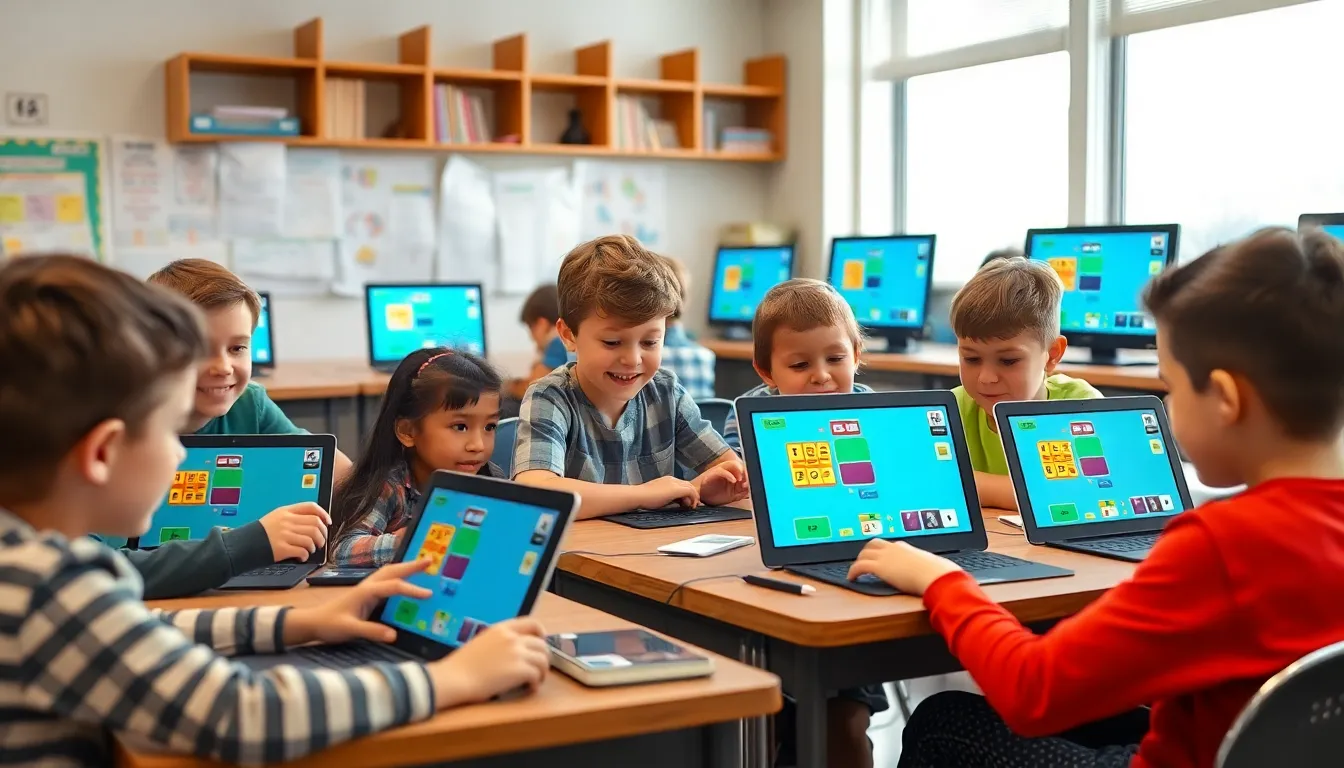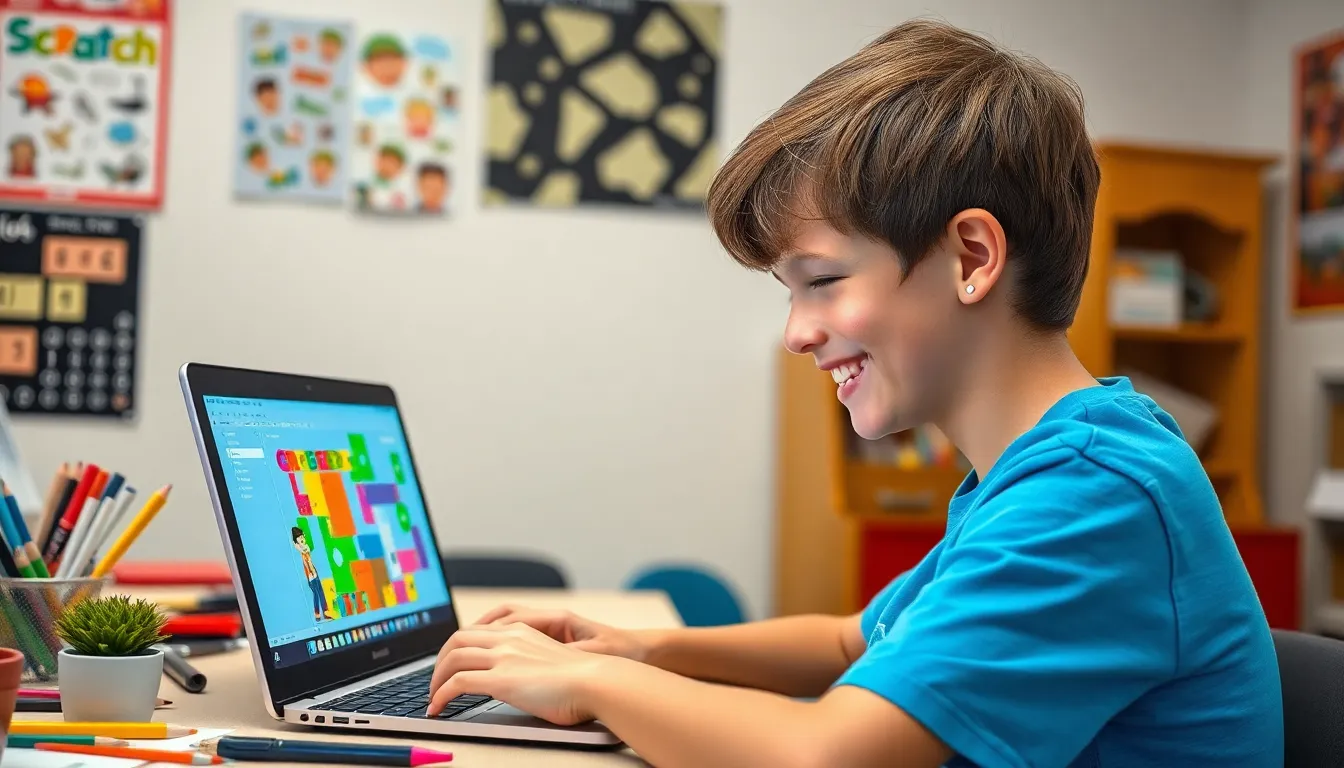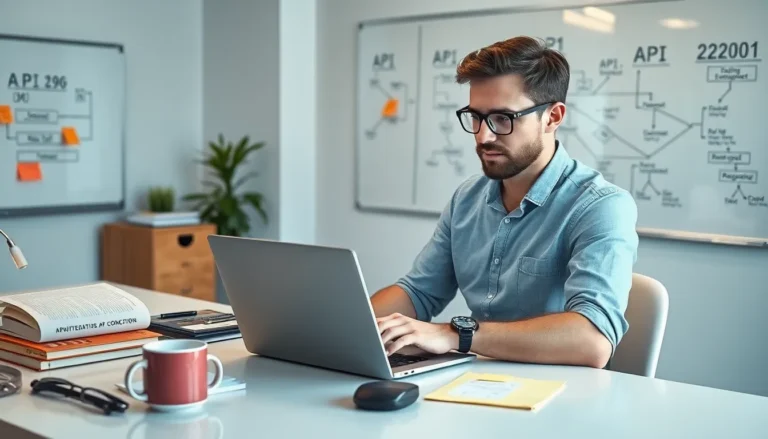In a world where technology reigns supreme, coding has become the new superpower. But wait—before you picture a dark room filled with caffeine-fueled programmers, let’s talk about Scratch coding. This vibrant platform turns coding into a playful adventure, making it easier for anyone to dive in and unleash their creativity.
Imagine building your own games or animations without needing a PhD in computer science. Scratch coding tutorials provide a fun and engaging way to learn the basics while keeping the boredom at bay. With colorful blocks and a dash of imagination, anyone can create something extraordinary. So grab your virtual cape and get ready to transform from a coding newbie to a digital maestro. Who knew learning could be this much fun?
Table of Contents
ToggleOverview of Scratch Coding Tutorials
Scratch coding tutorials provide an entry point into the world of programming for learners of all ages. These tutorials simplify complex concepts through visual programming blocks, making it easier to grasp key principles. Engaging lessons walk users through creating various projects, such as games or animations, fostering creativity.
Hands-on activities form a significant part of these tutorials, allowing learners to apply what they learn immediately. Each tutorial typically includes step-by-step instructions, guiding users from basic to advanced tasks. Interactive features enhance the experience by providing instant feedback, which fosters a deeper understanding.
Many resources are available online for Scratch coding tutorials, including official Scratch websites and community-driven platforms. These resources cater to various skill levels, from beginners to more experienced coders. Users can also explore video tutorials, which offer visual demonstrations that complement written materials.
A supportive community surrounds Scratch, encouraging collaboration and sharing among users. Participants can showcase their projects, receive feedback, and learn from each other’s experiences. This environment enhances motivation, as creators see the potential of their ideas realized in projects.
Scratch coding tutorials serve as a valuable tool for learning programming fundamentals. They emphasize creativity, collaboration, and practical application, making coding accessible and enjoyable. Engaging with these tutorials prepares individuals to navigate the digital landscape with confidence.
Benefits of Scratch Coding

Scratch coding provides numerous advantages for learners. It cultivates essential skills while keeping the process enjoyable and engaging.
Enhancing Creativity
Scratch encourages innovation through its visually stimulating interface. Users can design unique projects like games and animations, showcasing their imagination. Colorful blocks simplify programming concepts, allowing for personal expression. Engaging with Scratch inspires experimentation, enabling users to explore multiple ideas. The collaborative community further fosters creativity. Sharing projects leads to constructive feedback, promoting continuous improvement and exploration. This environment nurtures a culture of creativity, empowering individuals to think outside the box.
Building Logical Thinking
Logical thinking is a foundational skill honed through Scratch coding. Users break down complex problems into manageable components, fostering a structured approach to problem-solving. Each coding challenge requires users to plan their sequences methodically, reinforcing critical thinking. By debugging code, users develop perseverance and analytical abilities. As they work on projects, individuals learn to anticipate outcomes, refining their decision-making skills. This logic-centric learning prepares users for further programming languages and enhances overall cognitive development.
Types of Scratch Coding Tutorials
Scratch coding tutorials come in various types, each designed for different skill levels. These resources help users progress from beginners to advanced programmers, enhancing their coding journey.
Beginner Tutorials
Beginner tutorials introduce fundamental concepts of Scratch. Users learn about the interface, basic coding blocks, and simple project creation. Engaging activities focus on creating animations or basic games, allowing hands-on experience and creativity. Step-by-step instructions guide users through tasks like animating a character or making sounds, fostering confidence as they interact with the platform. Many beginner tutorials incorporate visuals like screenshots or videos, ensuring clarity. Resources can often be found on official Scratch websites and educational platforms dedicated to newcomers.
Intermediate Tutorials
Intermediate tutorials build on basic skills, introducing more complex concepts. Users explore advanced coding blocks and logic while developing engaging projects. Tutorials typically focus on creating multi-level games or interactive stories, enhancing problem-solving abilities. Resources may include project templates that challenge users to incorporate new features like variables or user inputs. Collaborative elements, such as sharing projects with peers, encourage feedback and constructive improvements. This stage in learning emphasizes refining skills and promoting creative expression through coding.
Advanced Tutorials
Advanced tutorials cater to users ready to tackle sophisticated projects. Participants engage with complex algorithms, data management, and game mechanics. Topics might include game design concepts and how to optimize code for performance. Users often work on unique, individual projects that showcase their coding knowledge and creativity. Resources may involve challenges to mentor others, enhancing the overall community experience. These tutorials focus heavily on critical thinking and allow users to push boundaries in Scratch coding, preparing them for future programming endeavors.
Recommended Scratch Coding Tutorials
Numerous resources exist to enhance the Scratch coding learning experience. These tutorials cater to various learning styles and levels, ensuring everyone can find suitable options.
Websites and Online Platforms
Official Scratch websites provide comprehensive tutorials for all skill levels. Users can explore interactive lessons structured around coding fundamentals and project creation. Platforms like Code.org and Codecademy also offer Scratch-specific courses. Each website emphasizes hands-on projects, enabling learners to apply coding skills in real-world scenarios. Organizations frequently update their resources, introducing new challenges and content to keep learners engaged.
YouTube Channels
Many YouTube channels focus solely on Scratch tutorials. Channels like “Scratch Team” feature official content, showcasing project ideas and coding techniques. Creators such as “CoderDojo” offer user-generated content that walks viewers through various projects. Channels often break down concepts into manageable chunks, promoting better understanding. Engaging video formats capture learners’ attention and encourage them to experiment with coding techniques showcased in the videos.
Community Resources
Online communities serve as valuable hubs for learning Scratch. The Scratch website hosts forums where users can discuss projects, ask questions, and share insights. Active members contribute tutorials, project ideas, and feedback, fostering collaboration. Platforms like GitHub also provide user-generated Scratch projects, allowing others to study and modify them. Participating in community events and challenges can further enhance coding skills while promoting a sense of belonging among learners.
Tips for Effective Learning with Scratch
Engaging with Scratch coding requires an understanding of its unique features. Start by exploring the Scratch interface to familiarize oneself with its layout and coding blocks. Users can enhance their learning by experimenting with different blocks, encouraging creativity as they design unique projects.
Practice consistently to solidify knowledge of coding concepts. Daily practice enables learners to apply skills and discover new ways to solve problems. Beginners should focus on mastering fundamental concepts before tackling more complex projects.
Seeking inspiration can fuel creativity and motivation. Browse projects shared within the Scratch community to see how others implement ideas. Observation promotes an understanding of diverse techniques, expanding the learner’s toolkit.
Utilizing available resources enhances the learning experience significantly. Online tutorials and community forums provide valuable insights, helping learners troubleshoot issues and improve their projects. Pairing video tutorials with hands-on practice solidifies concepts and boosts retention.
Collaboration enriches the coding journey. Engaging with peers allows for constructive feedback and idea-sharing, fostering a supportive learning environment. Participating in community challenges encourages users to push their boundaries and try new things.
Setting achievable goals can lead to motivation and a sense of accomplishment. By establishing clear milestones, users maintain focus and track their progress effectively. Celebrating small achievements along the way fosters a positive learning mindset.
Embracing mistakes as learning opportunities is essential. Debugging code teaches persistence and critical thinking, essential skills in programming. Reflecting on errors encourages a growth mindset, helping learners develop resilience in their coding journey.
Scratch coding tutorials provide a unique gateway into the world of programming for learners of all ages. By combining creativity with logical thinking these tutorials empower individuals to explore their potential as digital creators. The engaging interface and hands-on projects make learning enjoyable while fostering collaboration within a supportive community.
As users progress through various levels of tutorials they not only develop coding skills but also enhance critical thinking and problem-solving abilities. Embracing the resources available and participating in community interactions enriches the learning experience. With Scratch coding tutorials anyone can embark on a fulfilling journey that prepares them for future challenges in the tech-driven landscape.




